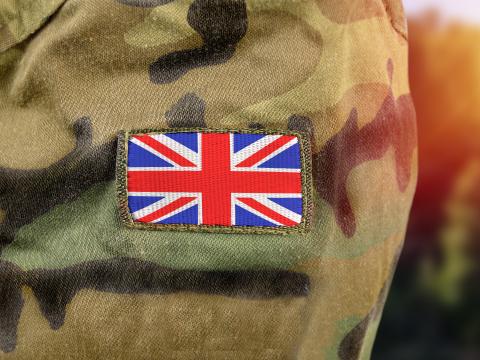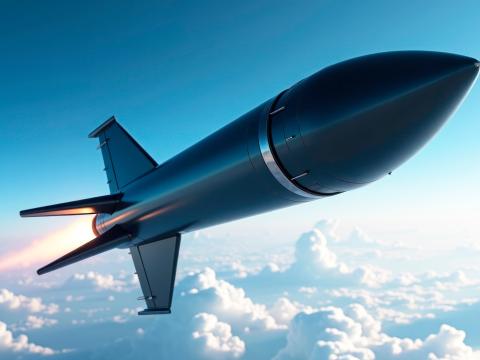Broadcast Manager Circumvents Communications Traffic Jam
In-theater information takes a new path to the soldier.
The U.S. Army is deploying a transportable satellite broadcast management and uplink system that features greater bandwidth than traditional satellite systems, reduces transmission time and frees space on other tactical communications equipment.
Disseminating large quantities of data to the warfighter at high speed has long been a priority of the services. The theater injection point system (TIPS) was designed to alleviate traffic on standard communications equipment such as microwave. The system allows commanders to transmit large files to their troops at a rate of 23.5 megabits per second on Ku-band frequencies and 12.5 megabits per second on Ka-band frequencies. TIPS operates with the U.S. Defense Department’s Global Broadcast Service and complements the Army’s other satellite tools.
Many tactical satellite systems used today must combine all voice, video and data information into one stream to send it to a satellite, says Staff Sgt. José Garcia, USA, chief, Satellite Communications Team, Delta Company, 40th Signal Battalion, 11th Signal Brigade, Fort Huachuca, Arizona. Recipients must download the entire stream and search through it to find what they need. With TIPS, the satellite sends specific scheduled information to designated units only, which saves time when crucial decisions must be made on the battlefield.
According to Sgt. Garcia, the theater-level system also has an advantage over most satellite communications vehicles, which have a limited number of receive units. Similar to direct television, TIPS accommodates an unlimited amount of receive units, which means “you can have as many users out in the field as you want receiving information from TIPS,” Sgt. Garcia says. He is among the first to train on TIPS.
TIPS comprises two main elements: a theater satellite broadcast manager and a transportable theater injector (TTI). The broadcast manager provides the interface between data sources and features security enclaves that process classified data and unclassified video and data. It operates based on a set of functions, processes and systems that collect information, assemble broadcast data streams and transmit the streams to an injection point for uplink. The TTI broadcasts information directly from a theater of operations in both the Ka band and the Ku band using a single antenna. If one satellite experiences heavy traffic, another satellite can be used.
The equipment can be mounted on two high mobility multipurpose wheeled vehicles (HMMWVs). However, four legs support the antenna structure so the HMMWV can be driven out from under it and the structure will stand alone.
The process of getting information to the warfighter begins with a theater commander who decides what programs, files and other information his units will need. “Then the theater information managers come in through the NIPRNET [unclassified but sensitive Internet protocol router network] and the SIPRNET [secret Internet protocol router network] and make sure all of the user identifications and other information are correct in the system,” the sergeant says. “Finally, we open a program to put an ‘x’ in a box that indicates which person is going to receive which information. We export all of the data to one file and send it to the U.S. Joint Forces Command (JFCOM), Norfolk, Virginia, which schedules the satellite times.
Each set of data, audio or video files—called a product—is given a time period in which it is transmitted. For example, the schedule may allow two minutes for a product to be relayed. But problems can occur when the system deals with video transmissions. Unlike data transmissions, which are sent in bursts, video broadcasts require different treatment. “If the transmission only takes a minute and a half, then 30 seconds of no broadcast occurs,” Sgt. Garcia shares. “The high-power amplifiers overheat when there is no signal,” he says. By constantly playing, the video fills in the gaps.” This solution is advantageous because a soldier could park the HMMWV in a combat zone, attach a video camera and allow a commander to observe troops in the field.
After a schedule has been designated, a computer inputs that information into a large file called an ingest. “JFCOM sends it back to us, and we ingest it into our system,” Sgt. Garcia says. “That schedule tells the computers to go out onto the SIPRNET or NIPRNET and grab the information and store it. It knows what information to collect, what time to broadcast it and to whom. During the broadcast window, it also is collecting updates to the original information. It sends the information out more than one time in a broadcast, but the data is updated.
The TIP system will then send the information to the subordinate units via a receive broadcast manager (RBM) that is connected to command post local area networks. The receiver is a little larger than a personal computer.
“Let’s say soldiers are in the field and they need to get information off a SIPR site but they can’t get it because they don’t have SIPR or NIPR access [in the field]. All they need is a receive station, and we can send it to them. It’s like wireless Internet,” Sgt. Garcia relates. TIPS also can access classified and unclassified local area networks from a tactical operations center and data products for broadcast.
Sgt. Garcia notes that the TIP system tested and deployed in the 11th Signal Brigade is just the beginning. “As we’re moving into the future, more and more data is being disseminated. With this system, you can pump out mass amounts of data, put out more information than with a normal satellite band,” he points out. “This is the first [TIP system] that the Army has. They’re taking our suggestions to make the new TIPS smaller, lighter and more capable. TIPS now is somewhat heavy. In the future, they’ll have a modem that does the work of two of our modems now. One up-converter will do the same as four up-converters.” The Joint Communications Satellite Center also is developing a shelter that can transmit on the X and C bands in addition to the Ka and Ku bands, all from one TIP system. This will give units increased flexibility with communications transmissions, he says.
Plans are in the works to field TIPS in Europe and Korea.



Comments